If you are making prints on tracing paper, labels, transparencies, nonstandard paper size stock, or envelopes, load the paper stock into the multi-purpose tray.
Standard Size
You can select standard A or B series paper, or inch paper.
Free Size
You can load free size paper 3 7/8" x 5 7/8" to 11 3/4" x 17" (99 mm x 148 mm to 297 mm x 431 mm).
Custom Size
You can load nonstandard paper sizes 3 7/8" x 5 7/8" to 11 3/4" x 17" (99 mm x 148 mm to 297 mm x 431 mm).
Envelope
No. 10(COM10) (4 1/8" × 9 1/2" (104.7 mm × 241.3 mm)), Monarch (3 7/8" × 7 1/2" (98.4 mm × 190.5 mm)), DL (4 3/8" × 8 5/8" (110 mm × 220 mm)), ISO-B5 (7" × 9 7/8" (176 mm × 250 mm)), ISO-C5 (6 3/8" × 9" (162 mm × 229 mm)), Nagagata 3 (4 3/4" × 9 1/4" (120 mm × 235 mm)), Yougatanaga 3 (4 3/4" × 9 1/4" (120 mm × 235 mm)), Kakugata 2 (9 1/2" × 13 1/8"(240 mm × 332 mm))
|
IMPORTANT
|
|
Note the following points when using the multi-purpose tray:
Paper Quantity: One to approximately (17 lb bond (64 g/m2), stack approximately 3/8" (10 mm) high)
Paper Size: 3 7/8" x 5 7/8" to 11 3/4" x 17" (99 mm x 148 mm to 297 mm x 431 mm)
Paper Weight: 16 lb bond to 80 lb cover (60 to 220g/m2)
Paper which has been rolled or curled must be straightened out prior to use, to allow the paper to feed smoothly through the multi-purpose tray (allowable curl amount: less than 3/8" (10 mm) for normal paper, less than 1/5" (5 mm) for heavy paper. There are some types of paper stock, which may meet the above specifications, but cannot be fed into the multi-purpose tray.
Make sure that you fan the sheets of paper well before placing them. Recycled paper, pre-punched paper, heavy paper, labels, and transparencies should be fanned particularly well before loading it.
Do not load different size/type paper at the same time.
Be sure to correctly set the paper type. When printing on special types of paper, such as heavy paper or transparencies, be sure to correctly set the paper type, especially if you are using heavy paper. If the type of paper is not set correctly, it could adversely affect the quality of the image. Moreover, the fixing unit may become dirty and require a service repair, or the paper could jam.
|
|
NOTE
|
|
For high-quality printouts, use paper recommended by Canon.
|
1.
Open the multi-purpose tray.
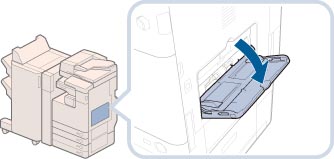
|
NOTE
|
|
If the paper size you are going to load into the multi-purpose tray is different from the paper size registered in [Register Multi-Purpose Tray Defaults] in [Preferences] (Settings/Registration), set [Register Multi-Purpose Tray Defaults] to 'Off'. (See "Registering Multi-Purpose Tray Defaults.")
|
Press [Select Paper] → specify the loaded paper → proceed to step 6.
Select the paper currently loaded in the multi-purpose tray, as shown below.

Check to see if any job is reserved. (See "Checking and Canceling Jobs from the Job Status Screen.")
If there is a current or reserved job, you can reserve a change of paper for the multi-purpose tray. For more information, see the following:
Reserving a Job Using a Paper Type Different to the Current Paper in the Multi-Purpose Tray for Copy
Reserving a Job Using a Paper Type Different to the Current Paper in the Multi-Purpose Tray for Access Stored Files
If there is no reserved job, remove any paper remaining in the multi-purpose tray → continue the procedure from step 2.
2.
Adjust the slide guides to match the size of the paper.
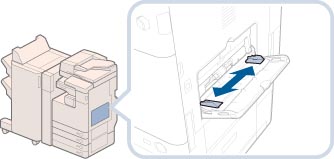
If you are feeding large size paper, pull out the auxiliary tray.
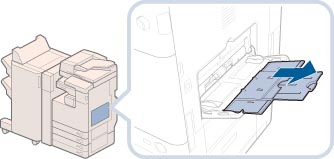
3.
Load the paper into the multi-purpose tray.
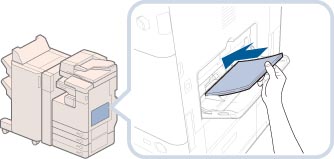
Make sure that the height of the paper stack does not exceed the loading limit mark (  ).
).
 ).
).If the paper is curled when using the multi-purpose tray, a paper jam may occur. Therefore, fix the curling as indicated in the diagram before loading the paper into the multi-purpose tray.
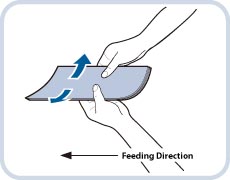
To print on the backside of preprinted paper, load the preprinted paper face down into the multi-purpose tray, as shown in the illustration below.
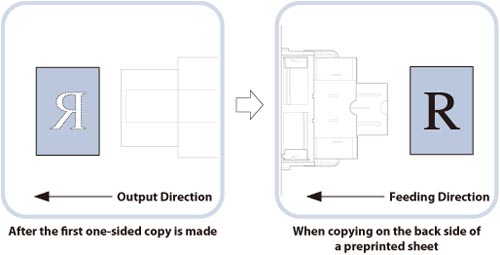
|
IMPORTANT
|
|
When loading paper into the multi-purpose tray, align the paper stack neatly between the slide guides. If the paper is not loaded correctly, a paper jam may occur.
When loading paper into the multi-purpose tray, align the paper stack evenly between the slide guides. The paper may not be fed if the slide guides are set to a position narrower than the paper, causing the paper to curl.
|
|
NOTE
|
|
If there are instructions on the paper package about which side of the paper to load, follow those instructions.
When the paper is loaded into the multi-purpose tray, the side facing down is the one printed on.
If problems, such as poor print quality or paper jams occur, try turning the paper stack over and reload it.
For more information on the print direction of preprinted paper (paper which has logos or patterns already printed on it), see "Relationship Between the Original Orientation and Paper Orientation."
|
Take five envelopes, loosen them as shown, and then stack them together.
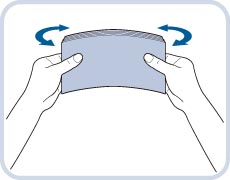
Repeat this step five times for each set of five envelopes.
Place the envelopes on a clean, level surface, and press all the way around the envelopes by hand, in the direction of the arrows, to remove any curls.

Repeat this step five times for each set of five envelopes.
Hold down the four corners of the envelopes firmly, so that they and the sealed or glued portion stay flat.

|
IMPORTANT
|
|
If you use envelopes that have glue attached to their flaps, the glue may melt due to the heat and pressure of the fixing unit.
Take special care to spread the envelopes out in the direction that they will be fed.
|
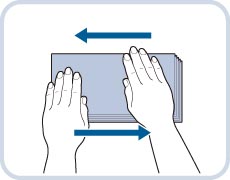
|
IMPORTANT
|
|
Do not print on the backside of the envelopes (the side with the flap).
If the envelopes become filled with air, flatten them by hand before loading them into the multi-purpose tray.
|
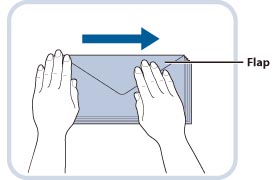
Load the envelopes in the direction indicated in the illustration.
If you are using Nagagata 3, Kakugata 2, or ISO-B5:
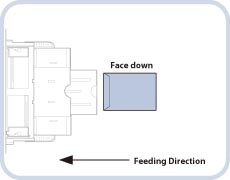
If you are using No. 10(COM10), Monarch, DL, ISO-C5, or Yougatanaga 3:

|
IMPORTANT
|
|
The multi-purpose tray can hold five envelopes at a time.
If the envelopes do not pass through the machine properly even if the procedures up to this point have been followed, repeat the procedures by feeding once for each envelope.
Fold the flap before loading the envelope in the multi-purpose tray, as shown in the illustration.
|
4.
Select the desired paper size.
|
IMPORTANT
|
|
Set the paper or envelope size to the same size as the paper or envelopes loaded in the multi-purpose tray.
|
Select the desired paper size → press [Next].
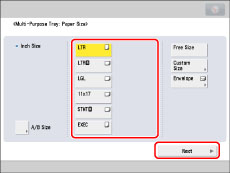
|
NOTE
|
|
To select an A or B series paper size, press [A/B-size].
|
Press [Free Size] → [Next].
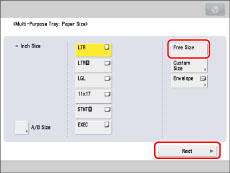
Press [Custom Size].
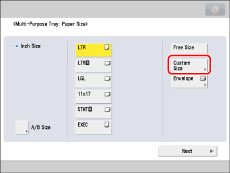
Press [X] and [Y] → enter each value → press [OK].
You can also select a size button ([S1] to [S5]) containing a stored paper size setting, instead of entering values.
|
NOTE
|
|
If you make a mistake when entering values, press
 (Clear) → enter the correct values. (Clear) → enter the correct values.To select a registered paper size stored in a size button ([S1] to [S5]), you must store the irregular paper size in the size button beforehand. For instructions on storing irregular paper sizes, see "Registering/Editing/Deleting Custom Paper Sizes."
|
Press [Next].
Press [Envelope].

If [Specify Multi-Purpose Tray Envelope Type] is set to 'On' in [Preferences] (Settings/Registration), select the envelope type → press [OK].

If [Specify Multi-Purpose Tray Envelope Type] is set to 'Off' in [Preferences] (Settings/Registration), you cannot select the envelope type. If you press [Envelope], No. 10(COM10) is automatically selected as the envelope type.
|
IMPORTANT
|
|
If the envelope type is not set correctly, a paper jam will occur.
|
Press [Next] → [OK] → proceed to step 6.
5.
Select the desired paper type → press [OK].
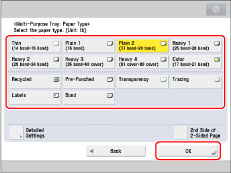
If you are using a paper type that is not listed, press [Detailed Settings] → select the paper type → press [OK].

If you are printing on the backside of a previously printed sheet, press [2nd Side of 2-Sided Page].
|
NOTE
|
|
Transparencies can be selected only if you select LTR as the paper size.
For more information on paper types, see "Available Paper Stock."
You can register paper types that are not listed in Detailed Settings for Selecting the Paper Type. For information on registering a custom paper type, see "Registering/Editing Custom Paper Types."
|
6.
Press [OK].
If a screen prompting you to adjust the slide guides is displayed, adjust the width of the slide guides → specify the paper size → press [OK].
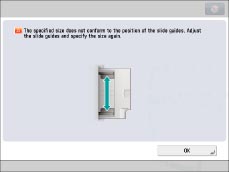
If a screen prompting you to adjust the slide guides or check [Register Multi-Purpose Tray Defaults] in Settings/Registration is displayed, adjust the width of the slide guides to match the paper size stored in Register Multi-Purpose Tray Defaults, or set [Register Multi-Purpose Tray Defaults] to 'Off' in [Preferences] (Settings/Registration). (See "Registering Multi-Purpose Tray Defaults.")
7.
Place your originals → select the desired settings.
If the Copy function is selected, place your originals.
If you are printing documents stored in a mail box, memory media, the Advanced Box, the Advanced Box of another imageRUNNER ADVANCE machine on the network, or the Fax/I-Fax Inbox, this step is not necessary.
8.
Press  (Start).
(Start).
 (Start).
(Start). If you are printing stored files, press [Start Printing].
Scanning or printing starts.
|
NOTE
|
|
To cancel all settings and return the machine to the default mode, press
 (Reset). The default settings are restored. However, even if you have selected files in [Access Stored Files], the files will be deselected. (Reset). The default settings are restored. However, even if you have selected files in [Access Stored Files], the files will be deselected. |
|
IMPORTANT
|
|
Feed tracing paper one sheet at a time, and remove each sheet as it is delivered to the output tray. Loading several sheets together may cause paper jams.
Depending on the type of heavy paper you want to load, if you load multiple sheets of heavy paper into the multi-purpose tray, a paper jam may occur. In this case, load only one sheet of heavy paper at a time.
If you are making two-sided prints, select the 2-Sided mode. The printed-paper may crease depending on the moisture absorption condition of the paper.
To print on the backside of preprinted paper, load the paper into the multi-purpose tray, and press [2nd Side of 2-Sided Page] on the paper selection screen that appears.
If you are printing on envelopes, do not allow more than 10 envelopes to accumulate in the output tray. Always empty the output tray once 10 envelopes have accumulated.
|
|
NOTE
|
|
When scanning the following originals, you cannot use the Automatic Paper Selection mode. Use the Manual Paper Selection mode when scanning these types of originals:
Transparencies and other highly transparent objects
Originals with an extremely dark background
Envelopes may be creased in the printing process.
|